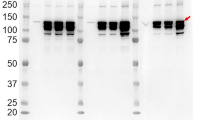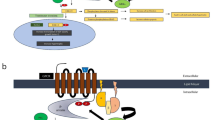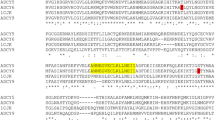Abstract
ANF-RGC membrane guanylate cyclase is the receptor for the hypotensive peptide hormones, atrial natriuretic factor (ANF) and type B natriuretic peptide (BNP). It is a single transmembrane spanning protein. Binding the hormone to the extracellular domain activates its intracellular catalytic domain. This results in accelerated production of cyclic GMP, a second messenger in controlling blood pressure, cardiac vasculature, and fluid secretion. ATP is the obligatory transducer of the ANF signal. It works through its ATP regulated module, ARM, which is juxtaposed to the C-terminal side of the transmembrane domain. Upon interaction, ATP induces a cascade of temporal and spatial changes in the ARM, which, finally, result in activation of the catalytic module. Although the exact nature and the details of these changes are not known, some of these have been stereographed in the simulated three-dimensional model of the ARM and validated biochemically. Through comprehensive techniques of steady state, time-resolved tryptophan fluorescence and Forster Resonance Energy Transfer (FRET), site-directed and deletion-mutagenesis, and reconstitution, the present study validates and explains the mechanism of the model-based predicted transduction role of the ARM’s structural motif, 669WTAPELL675. This motif is critical in the ATP-dependent ANF signaling. Molecular modeling shows that ATP binding exposes the 669WTAPELL675 motif, the exposure, in turn, facilitates its interaction and activation of the catalytic module. These principles of the model have been experimentally validated. This knowledge brings us a step closer to our understanding of the mechanism by which the ATP-dependent spatial changes within the ARM cause ANF signaling of ANF-RGC.










Similar content being viewed by others
Abbreviations
- ANF:
-
Atrial natriuretic factor
- BNP:
-
B-type natriuretic peptide
- ANF-RGC:
-
Atrial natriuretic factor receptor guanylate cyclase
- ARM:
-
ATP regulated module
- FRET:
-
Förster resonance energy transfer
- Mant-ATP:
-
2′-0-(N-methylantraniloyl)-adenosine 5′-triphosphate
References
Paul AK, Marala RB, Jaiswal RK, Sharma RK (1987) Coexistence of guanylate cyclase and atrial natriuretic factor receptor in a 180-kD protein. Science 235:1224–1226. doi:10.1126/science.2881352
Paul AK (1986) Particulate guanylate cyclase from adrenocortical carcinoma 494. Purification, biochemical and immunological characterization. Doctoral thesis, University of Tennessee
Kuno T, Andersen JW, Kamisaki T, Waldman SA, Chang LY, Saheki S, Leitman DC, Nakane M, Murad F (1986) Co-purification of an atrial natriuretic factor receptor and particulate guanylate cyclase from rat lung. J Biol Chem 261:5817–5823
Pandey KN, Pavlou SN, Inagami T (1988) Identification and characterization of three distinct atrial natriuretic factor receptors. Evidence for tissue-specific heterogeneity of receptor subtypes in vascular smooth muscle, kidney tubular epithelium, and Leydig tumor cells by ligand binding, photoaffinity labeling, and tryptic proteolysis. J Biol Chem 263:13406–13413
Meloche S, McNicoll N, Liu B, Ong H, De Lean A (1988) Atrial natriuretic factor R1 receptor from bovine adrenal zona glomerulosa: purification, characterization, and modulation by amiloride. Biochemistry 27:8151–8158. doi:10.1021/bi00421a025
Sharma RK (2002) Evolution of the membrane guanylate cyclase transduction system. Mol Cell Biochem 230:3–30. doi:10.1023/A:1014280410459
Sharma RK, Duda T, Venkataraman V, Koch K-W (2004) Calcium-modulated mammalian membrane guanylate cyclase ROS-GC transduction machinery in sensory neurons: a universal concept. Curr Top Biochem Res 6:111–144
Duda T, Goraczniak R, Sharma RK (1991) Site-directed mutational analysis of a membrane guanylate cyclase cDNA reveals the atrial natriuretic factor signaling site. Proc Natl Acad Sci USA 88:7882–7886. doi:10.1073/pnas.88.17.7882
Chinkers M, Garbers DL, Chang MS, Lowe DG, Chin HM, Goeddel DV, Schulz S (1989) A membrane form of guanylate cyclase is an atrial natriuretic peptide receptor. Nature 338:78–83. doi:10.1038/338078a0
Lowe DG, Chang MS, Hellmiss R, Chen E, Singh S, Garbers DL, Goeddel DV (1989) Human atrial natriuretic peptide receptor defines a new paradigm for second messenger signal transduction. EMBO J 8:1377–1384
Chang MS, Lowe DG, Lewis M, Hellmiss R, Chen E, Goeddel DV (1989) Differential activation by atrial and brain natriuretic peptides of two different receptor guanylate cyclases. Nature 341:68–72. doi:10.1038/341068a0
Duda T, Goraczniak RM, Sitaramayya A, Sharma RK (1993) Cloning and expression of an ATP-regulated human retina C-type natriuretic factor receptor guanylate cyclase. Biochemistry 32:1391–1395. doi:10.1021/bi00057a001
Schulz S, Green CK, Yuen PS, Garbers DL (1990) Guanylyl cyclase is a heat-stable enterotoxin receptor. Cell 3:941–948. doi:10.1016/0092-8674(90)90497-3
Koller KJ, Lowe DG, Bennett GL, Minamino N, Kangawa K, Matsuo H, Goeddel DV (1991) Selective activation of the B natriuretic peptide receptor by C-type natriuretic peptide (CNP). Science 252:120–123. doi:10.1126/science.1672777
Schultz S, Singh S, Bellet RA, Singh G, Tubb DJ, Chin H, Garbers DL (1989) The primary structure of a plasma membrane guanylate cyclase demonstrates diversity within this new receptor family. Cell 58:1155–1162. doi:10.1016/0092-8674(89)90513-8
Duda T, Sharma RK (2008) ONE-GC membrane guanylate cyclase, a trimodal odorant signal transducer. Biochem Biophys Res Commun 367:440–445. doi:10.1016/j.bbrc.2007.12.153
Labrecque J, Mc Nicoll N, Marquis M, De Lean A (1999) A disulfide-bridged mutant of natriuretic peptide receptor-A displays constitutive activity. Role of receptor dimerization in signal transduction. J Biol Chem 274:9752–9759. doi:10.1074/jbc.274.14.9752
Yu H, Olshevskaya E, Duda T, Seno K, Hayashi F, Sharma RK, Dizhoor AM, Yamazaki A (1999) Activation of retinal guanylyl cyclase-1 by Ca2+-binding proteins involves its dimerization. J Biol Chem 274:15547–15555. doi:10.1074/jbc.274.22.15547
Wilson EM, Chinkers M (1995) Identification of sequences mediating guanylyl cyclase dimerization. Biochemistry 34:4696–4701. doi:10.1021/bi00014a025
Thorpe DS, Niu S, Morkin E (1991) Overexpression of dimeric guanylyl cyclase cores of an atrial natriuretic peptide receptor. Biochem Biophys Res Commun 180:538–544. doi:10.1016/S0006-291X(05)81098-8
Liu Y, Ruoho AE, Rao VD, Hurley JH (1997) Catalytic mechanism of the adenylyl and guanylyl cyclases: modeling and mutational analysis. Proc Natl Acad Sci USA 94:13414–13419. doi:10.1073/pnas.94.25.13414
de Bold AJ (1985) Atrial natriuretic factor: a hormone produced by the heart. Science 230:767–770. doi:10.1126/science.2932797
Pandey KN (2005) Biology of natriuretic peptides and their receptors. Peptides 26:901–932. doi:10.1016/j.peptides.2004.09.024
de Bold AJ, de Bold ML (2005) Determinants of natriuretic peptide production by the heart: basic and clinical implications. J Investig Med 53:371–377. doi:10.2310/6650.2005.53710
John SW, Krege JH, Oliver PM, Hagaman JR, Hodgin JB, Pang SC, Flynn TG, Smithies O. Genetic decreases in atrial natriuretic peptide and salt-sensitive hypertension. Science 267:679–681. Erratum in Science 1995, 267:1753. doi:10.1126/science.7839143
Lopez MJ, Wong SK, Kishimoto I, Dubois S, Mach V, Friesen J, Garbers DL, Beuve A (1995) Salt-resistant hypertension in mice lacking the guanylyl cyclase-A receptor for atrial natriuretic peptide. Nature 378:65–68. doi:10.1038/378065a0
Kurose H, Inagami T, Ui M (1987) Participation of adenosine 5′-triphosphate in the activation of membrane-bound guanylate cyclase by the atrial natriuretic factor. FEBS Lett 219:375–379. doi:10.1016/0014-5793(87)80256-9
Chang CH, Kohse KP, Chang B, Hirata M, Jiang B, Douglas JE, Murad F (1990) Characterization of ATP-stimulated guanylate cyclase activation in rat lung membranes. Biochim Biophys Acta 1052:159–160. doi:10.1016/0167-4889(90)90071-K
Chinkers M, Singh S, Garbers DL (1991) Adenine nucleotides are required for activation of rat atrial natriuretic peptide receptor/guanylyl cyclase expressed in a baculovirus system. J Biol Chem 266:4088–4093
Marala RB, Sitaramayya A, Sharma RK (1991) Dual regulation of atrial natriuretic factor-dependent guanylate cyclase activity by ATP. FEBS Lett 281:73–76. doi:10.1016/0014-5793(91)80361-6
Duda T, Venkataraman V, Ravichandran S, Sharma RK (2005) ATP-regulated module (ARM) of the atrial natriuretic factor receptor guanylate cyclase. Peptides 26:969–984. doi:10.1016/j.peptides.2004.08.032
Goraczniak RM, Duda T, Sharma RK (1992) A structural motif that defines the ATP-regulatory module of guanylate cyclase in atrial natriuretic factor signalling. Biochem J 282:533–537
Foster DC, Garbers DL (1998) Dual role for adenine nucleotides in the regulation of the atrial natriuretic peptide receptor, guanylyl cyclase-A. J Biol Chem 273:16311–16318. doi:10.1074/jbc.273.26.16311
Burczynska B, Duda T, Sharma RK (2007) ATP signaling site in the ARM domain of atrial natriuretic factor receptor guanylate cyclase. Mol Cell Biochem 301:193–207. doi:10.1007/s11010-006-9400-7
Antos LK, Abbey-Hosch SE, Flora DR, Potter LR (2005) ATP-independent activation of natriuretic peptide receptors. J Biol Chem 280:26928–26932. doi:10.1074/jbc.M505648200
Antos LK, Potter LR (2007) Adenine nucleotides decrease the apparent K m of endogenous natriuretic peptide receptors for GTP. Am J Physiol Endocrinol Metab 293:E1756–E1763. doi:10.1152/ajpendo.00321.2007
Joubert S, Jossart C, McNicoll N, de Lean A (2005) Atrial natriuretic peptide-dependent photolabeling of a regulatory ATP-binding site on the natriuretic peptide receptor-A. FEBS J 272:5572–5580. doi:10.1111/j.1742-4658.2005.04952.x
Duda T, Yadav P, Jankowska A, Venkataraman V, Sharma RK (2001) Three dimensional atomic model and experimental validation for the ATP-Regulated Module (ARM) of the atrial natriuretic factor receptor guanylate cyclase. Mol Cell Biochem 217:165–172. doi:10.1023/A:1007236917061
Sharma RK, Yadav P, Duda T (2001) Allosteric regulatory step and configuration of the ATP-binding pocket in atrial natriuretic factor receptor guanylate cyclase transduction mechanism. Can J Physiol Pharmacol 79:682–691. doi:10.1139/cjpp-79-8-682
Koradi R, Billeter M, Wüthrich K (1996) MOLMOL: a program for display and analysis of macromolecular structures. J Mol Graph 14:51–55. doi:10.1016/0263-7855(96)00009-4
Sambrook MJ, Fritsch EF, Maniatis T (1989) Molecular cloning: a laboratory manual, 2nd edn. Cold Spring Harbor Laboratory, Cold Spring Harbor, NY
Nambi P, Aiyar NV, Sharma RK (1982) Adrenocorticotropin-dependent particulate guanylate cyclase in rat adrenal and adrenocortical carcinoma: comparison of its properties with soluble guanylate cyclase and its relationship with ACTH-induced steroidogenesis. Arch Biochem Biophys 217:638–646. doi:10.1016/0003-9861(82)90545-8
Gryczynski I, Wiczk W, Inesi G, Squier T, Lakowicz JR (1989) Characterization of the tryptophan fluorescence from sarcoplasmic reticulum adenosinetriphosphatase by frequency-domain fluorescence spectroscopy. Biochemistry 28:3490–3498. doi:10.1021/bi00434a051
Demchenko AP, Gryczynski I, Gryczynski Z, Wiczk W, Malak H, Fishman M (1993) Intramolecular dynamics in the environment of the single tryptophan residue in staphylococcal nuclease. Biophys Chem 48:39–48. doi:10.1016/0301-4622(93)80040-P
Lakowicz JR, Zelent B, Gryczynski I, Kuśba J, Johnson ML (1994) Distance-dependent fluorescence quenching of tryptophan by acrylamide. Photochem Photobiol 60:205–214. doi:10.1111/j.1751-1097.1994.tb05092.x
Lakowicz JR, Kuśba J, Szmacinski H, Johnson ML, Gryczynski I (1993) Distance-dependent fluorescence quenching observed by frequency-domain fluorometry. Chem Phys Lett 206:455–463. doi:10.1016/0009-2614(93)80167-N
Zhou T, Rosen BP (1997) Tryptophan fluorescence reports nucleotide-induced conformational changes in a domain of the ArsA ATPase. J Biol Chem 272:19731–19737. doi:10.1074/jbc.272.32.19731
Acknowledgment
This study was supported by NIH grants HL 070015, HL084584 (TD), DC 005349 (RKS), MD001633 (SB), and Texas Emerging Technologies Grant (IG and ZG)
Author information
Authors and Affiliations
Corresponding authors
Rights and permissions
About this article
Cite this article
Duda, T., Bharill, S., Wojtas, I. et al. Atrial natriuretic factor receptor guanylate cyclase signaling: new ATP-regulated transduction motif. Mol Cell Biochem 324, 39–53 (2009). https://doi.org/10.1007/s11010-008-9983-2
Received:
Accepted:
Published:
Issue Date:
DOI: https://doi.org/10.1007/s11010-008-9983-2




